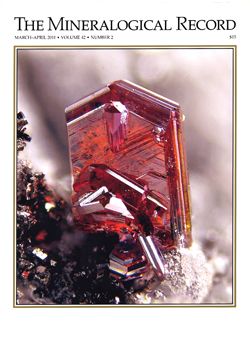From the Mineral Minutes Archives: Thoughts on a Snowy Day – February 6, 2010 – with a Bonus Quiz!
by Dave Nanney, MSDC Member and Past President, and Sue Fisher, MSDC Member and former Editor
[Editor's note: This item appeared in the March 2010 edition of Mineral Minutes]
What do you do when you are in the middle of a record-breaking snowstorm and you just received your Mineralogical Record – January-February, 2010. The answer is you read it.

But when you are the “kids” on the mineralogical scene, there are a lot of terms you are not sure of. Below are a number of terms from the January-February, 2010 edition of the magazine. I looked them up on various internet sites, sometimes several, if the meaning could not be understood, and our Geology 101 textbook . The references are too many to list so I will simply refer to the wisdom of the internet as the source of the definitions.
Note from Sue Fisher, Editor of February 2010 Edition: "I just can't leave good things alone so I decided to turn Dave's great information into a quiz. I have taken Dave's terms and definitions and mixed them up. Can you match the terms with their definitions? Just to challenge Dave a little, I have added a few more terms. Answers are at the end."
__1. Body of rock, which is thick in middle and thin at the edges, resembling convex lens.
__2. CaF2
__3. Crystalline minerals, framework silicate, most common are plagioclase (tends to be white, gray or blue) and orthoclase (tends to be pink)
__4. Space made by splitting of rock formation
__5. Separable into layers, repetition of layers in metamorphic rock
__6. Structures caused by extension where rigid body is stretched like sausage
__7. Material left after removal of valuable material. Trash minerals where one man’s trash might become another man’s treasure.
__8. Aragonite
__9. “Twisted quartz” where the crystal appears to have grown sideways, slightly twisted with bent crystal faces.
__10. Gneiss from sedimentary rock
__11. Skilled mountain climber and collector of minerals
__12. Soil is made of layers called horizons. Evaporate horizon would be repeated layers of evaporated minerals
__13. Block of earth crust displaced as a unit without internal changes
__14. Large mass thrust over other rocks
__15. Change in constitution of rock affected by heat, pressure, water yielding compact crystalline condition. Because this is not a cause of melting, this is considered a solid state transformation.
__16. Mass of intruded igneous rock that stopped its rise considerable distance before the surface.
__17. Process of mountain formation
__18. Metamorphic crystalline rock which has closely foliated structures and can be split along parallel planes. Medium to coarse grained metamorphic rock containing foliation.
__19. Mechanical Inclusion, and Substitution
__20. Gneiss from igneous rock
__21. Sequence of time in which a mineral crystallizes with respect to other minerals. Important with what it tells about the time and influences of minerals
__22. Foliated metamorphic rock, granite. Compositionally layered metamorphic rock, typically composed of alternating dark-colored and light-colored layers or lenses.
__23. Deposits formed from hot fluids.
a. Gwindels
b. Boudins
c. Orthogneiss
d. Flos Ferri
e. Two causes of color
f. Foliated
g. Strahler
h. Paragneiss
i. Metamorphic
j. Horizon of evaporate
k. Nappes w. Gneiss
l. Hydrothermal
m. Fluorite
n. Batholith
o. Lenses
p. Paragenesis
q. Orogeny
r. Feldspar
s. Cleft
t. Schist
u. Gangue
v. Massif
w. Gneiss
Answers to the Quiz: (Don't look at these until you have tried to answer the quiz.)
1. - o, 2. - m, 3. - r, 4. - s, 5. - f, 6. - b, 7. - u, 8. - d, 9. - a, 10. - h, 11. - g, 12. - j,
13. - v, 14. - k, 15. - i, 16. - n, 17. - q, 18. - t, 19. - e, 20. - c, 21. - p, 22. - w, 23. - l

